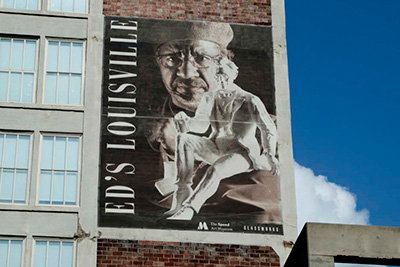Where our army has gone and established a long-term presence, there has sprouted an interest in America’s game…” – Patrick Donley
“Taijitu (South Korea)" by Patrick Donley, 20x26in, mixed media on arches (2016)
Not very long ago, we were discussing the use of flags in art, and their importance as symbols. Patrick Donley is a painter, sculptor, and collage artist who uses found materials to a significant degree. In his artist’s statement for his new exhibit at Lenihan Sotheby’s International Realty, he provides insight into his process, but also illuminates how the weight of memory in reclaimed objects can raise the artist’s own awareness through discovery, in this case, tying in to themes of geo-political influence.
“The Flags series began as an excuse to use the imagery of ‘America’s Game’ in my art. For years, I have been fascinated by the gritty, rugged, glorious, and often tarnished visual lexicon of baseball, a game full of heroes, heroines, legends, myths, successes and failures.
The choice to use the flag as an inspiration was somewhat accidental. I had been making collage paintings on paper that were made up of horizontal bands like the strata of the earth, or like the stripes on a flag. The paintings being on paper seemed appropriate, more ephemeral - more flag-like. I came across a cache of baseball images I had saved including some torn up baseball cards found while walking my dogs (the source for much of my collage). So the Baseball Flags were born (however, I never understood why the championship is called ‘the World Series’).
“The Girl Next Door (Aruba)" by Patrick Donley, 20x26in, mixed media on arches (2016)
The first pieces were mainly suggestive of flags: very colorful with lots of random collage, words and letters buried in the paint. After making about ten of these, I chose to leave the idea for a while and venture elsewhere, as is my way of working. Several years and several very different bodies of work ensued.
One day last year, I decided to revisit the flags, but this time I thought to use flags of the world as the platform. I had done a large commission piece for Kentucky Refugee Ministries here in Louisville, and while cleaning the studio I came across the images of all of the flags that represent the refugees who have been resettled into our town, and thus, these were my initial inspirations. After completing several, though interesting conceptually, something just did not feel right about the flags I was using, other than their graphic nature. Where was the connection to baseball?
“8 Men Out (Venezuela)” by Patrick Donley, 19x26in (framed), mixed media on arches (2016)
So I researched how many countries are actually represented by players throughout the major leagues. The number varied, but twenty-something is the rough tally. From that point on, the flags became about countries that have contributed players to the sport.
One of the fun challenges of using ‘real’ flags as the departure point is that there is not a huge diversity of colors used in national flags. It is a fairly basic palette, which allows me the license to explore layering, variation, and texture.
“Daddy-O” by Patrick Donley, 8x8in, mixed media on wood (2015)
At this point, I began to connect the dots between our military presence throughout the world and the growth of baseball in many of those places. It made sense. Where our army has gone and established a long-term presence, there has sprouted an interest in America’s game: Japan, Korea, Germany, Cuba, and Vietnam. But the list extends well beyond that to some places that honestly I could not guess why players would come from there: Australia, the Netherlands, Aruba, Venezuela, Columbia, Greece Baseball, Taiwan, Curacao, Brazil. And the list goes on.
It fascinates me that although Soccer is the ‘World’s’ game, Baseball has ‘the World Series’, and now, for me, that phrase finally makes a little more sense.”
Flags: A World Series, New Work by Patrick Donley, is now on exhibit at Lenihan Sotheby’s International Realty at 3803 Brownsboro Road in Louisville. There is an Artist Open House Thursday, February 16, 5:00-7:30pm. On March 3, Donley will open The Memento Series: Travel and Leisure at Craft(s) Gallery in Louisville.
Hometown: Louisville, Kentucky
Age: 54
Education: BA in Painting, Davidson College in Painting; MFA in Painting and Drawing, Northwestern University
Website: http://patrickdonley.wix.com/donleyart
“Beer Is Food” by Patrick Donley, 8x8in, mixed media on wood (2016)
Written by Keith Waits. Entire contents copyright © 2016 Louisville Visual Art. All rights reserved.
Are you interested in being on Artebella? Click here to learn more.

































